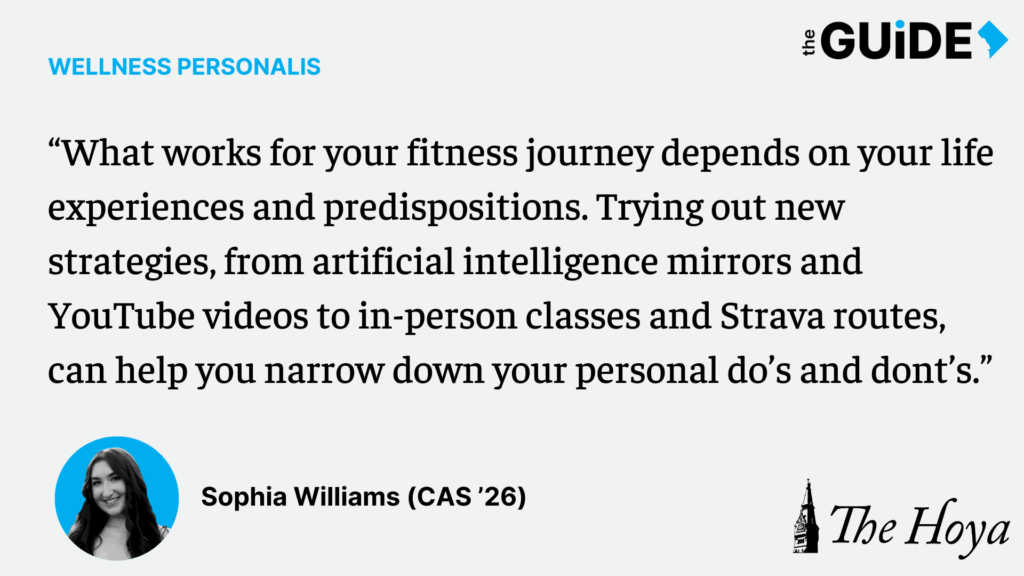Imagine returning to your room and finding your roommate working out in front of a mirror — and not just any mirror, but a mirror with a built-in Artificial Intelligence personal trainer monitoring their form. Depending on your opinion about AI, your reaction might be anything from scared to excited (or even confused about how your roommate managed to find the space in your dorm for a huge AI mirror).
Today, I’m going to focus on whether AI and other online fitness apps can actually replace the benefits of in-person fitness.
Let’s take the built-in Apple Health and Fitness apps, for example. If you have an iPhone, you can track your daily steps, movement, workouts and standing goals even without an Apple Watch.
You can connect third-party apps to these programs and allow them to share your workout data for the goal of tracking your “fitness.” For example, you can complete a guided run with the free Nike Run Club and send the data to your Apple Fitness app. The Nike Training Club allows you to log all your workouts in their app and encourages you to push yourself with their “Breakthrough Challenges.”
These apps and others like them record your workout data, and the aforementioned AI mirrors use AI feedback to critique your form. They make working out possible from anywhere and remove the need to work with personal trainers or other teaching professionals. Still, these apps make me wonder whether successful fitness requires interpersonal relationships — and whether tracking fitness helps or hinders your progress.
In terms of the interpersonal question, certain areas of fitness might need some level of in-person training. For example, watching a yoga teacher enter a pose from all angles while receiving personalized feedback based on their holistic knowledge of yoga can be very helpful. Human yoga teachers can also empathize with you on days you’re feeling more tired and spot you when you try to enter into a pose.
Moreover, going to a class with others trying to achieve similar fitness goals can be inspiring and energizing. I find that I challenge myself more when I’m going to a fitness class with friends instead of taking an online class alone. After all, online, no one knows if I skip a certain pose that I know I could have done.
Nevertheless, online fitness offers numerous benefits. For example, some of my friends are fans of Strava, a running app that monitors your heart rate, power meter and more, all while tracking your route. They especially love the built-in social network of Strava, where runners can upload their activities and friends can give “kudos” or leave comments. Runners can even use Strava as a route resource, competing against others’ times on popular routes or using a friend’s route as inspiration. In these ways, Strava makes up for the lack of interpersonal relationships characteristic of fitness apps.
However, fitness tracking can be a slippery slope if not done in a healthy manner. Tracking fitness should motivate users to attain new personal bests and stay committed to their practice, but sometimes it has the opposite effect. Some users feel that if they can’t reach a particular goal for the day, they shouldn’t try to exercise at all.
Personally, I regularly used an Apple Watch two years ago, but the watch would delegitimize my achievements and highlight my rough days. Apple Watches don’t know your emotional or physical limits — the built-in trackers would compare my days to let me know when I “failed” to make a new personal best. Instead of helping me make fitness a part of my lifestyle, the Apple Watch made fitness an unending and frustrating experience.
I offer my experience not to discourage you from trying fitness tracking hardware but to show you the subjective nature of fitness. For some, counting steps and activity levels to compete against yourself or others can be a great motivator. What works for your fitness journey depends on your life experiences and predispositions. Trying out new strategies, from AI mirrors and YouTube videos to in-person classes and Strava routes, can help you narrow down your personal do’s and don’ts.
Great fitness and a healthy lifestyle can come from all kinds of different places, and they look different for everyone. The most important thing to remember is that it all starts somewhere — and you don’t necessarily need fancy machines or data to help you begin your fitness journey.
Sophia Williams is a first-year in the College of Arts & Sciences. Wellness Personalis will appear online and in print every three weeks.














